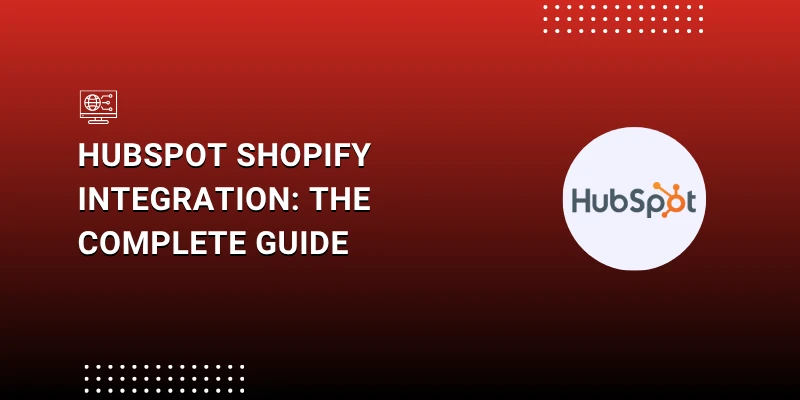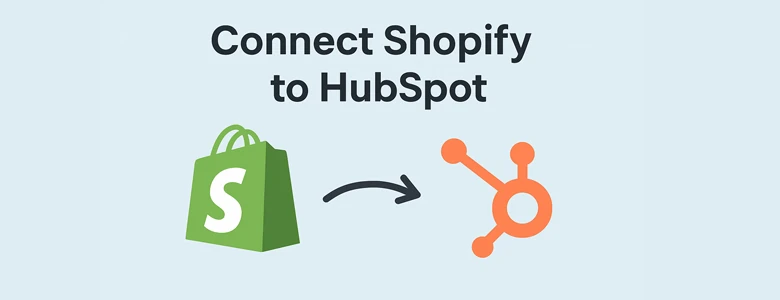
In today’s digital world, managing your online store and marketing in one place is a game-changer. That’s exactly what the HubSpot Shopify integration helps you achieve. It connects Shopify’s powerful e-commerce tools with HubSpot’s all-in-one marketing, sales, and CRM platform. Whether you run a small Shopify store or manage a growing e-commerce brand, this integration helps you streamline operations, improve customer engagement, and increase sales.
In this complete guide, we’ll explore how HubSpot Shopify integration works, what its key benefits are, and how you can set it up easily to grow your business.
What Is HubSpot Shopify Integration?
The HubSpot Shopify integration is a seamless connection between your Shopify store and HubSpot CRM. It syncs all your important data—like customers, products, and orders—directly into HubSpot. Once connected, you can automate your marketing, track your sales performance, and create personalized campaigns without leaving your HubSpot dashboard.
In simple words, HubSpot for Shopify helps you bring marketing and sales together. You can manage your store data, segment customers based on their behavior, and send targeted emails—all from one platform.
Why HubSpot and Shopify Make a Perfect Pair?
HubSpot for Shopify is more than just a data connection—it’s a partnership between two powerful platforms. Shopify helps you build and manage your online store, while HubSpot allows you to attract, nurture, and convert leads.
Here’s why the HubSpot Shopify integration is so powerful:
- Centralized data management: Your customer and order data stay synced in real time.
- Automated marketing: Send emails and track engagement automatically.
- Personalized campaigns: Segment customers based on purchases, preferences, or browsing history.
- Better insights: Measure revenue, marketing ROI, and abandoned cart recovery.
Together, HubSpot and Shopify create a smart ecosystem that helps e-commerce businesses grow faster and smarter.
Key Benefits of HubSpot Shopify Integration
Integrating HubSpot for e-commerce with Shopify opens up a world of opportunities. Let’s explore the top benefits you’ll get from this connection:
- Unified Customer Data
With HubSpot Shopify integration, every new customer, order, and product automatically syncs with HubSpot. You don’t need to export or manually upload data anymore. This means all your marketing and sales efforts are based on accurate, real-time information.
- Smarter Email Marketing
HubSpot for Shopify makes email marketing easier and more effective. You can create automated workflows to send welcome emails, product recommendations, or cart recovery messages. HubSpot tracks open rates and clicks so you can see which campaigns work best.
- Advanced Segmentation
The integration allows you to segment your customers based on purchase history, spending habits, and engagement levels. This helps you send more relevant messages that drive conversions. For example, you can target loyal buyers with exclusive offers or re-engage inactive customers.
- Sales and Marketing Alignment
The HubSpot Shopify integration bridges the gap between your marketing and sales teams. Your sales team can see detailed insights about each customer—what they bought, when they last visited, and which emails they opened. This data helps them close deals faster and more effectively.
- Automated Workflows and Lead Nurturing
You can build automated workflows in HubSpot to nurture leads and drive repeat purchases. For example:
- Send a “thank you” email after a customer makes a purchase.
- Trigger reminders for abandoned carts.
- Share personalized product recommendations.
Automation saves time and ensures that every customer receives the right message at the right time.
How to Set Up HubSpot Shopify Integration?

Setting up the HubSpot Shopify integration is easy. Here’s a step-by-step guide to get you started.
Step 1: Connect Shopify to HubSpot
- Go to your HubSpot account and navigate to the Marketplace.
- Search for “Shopify Integration.”
- Click Install App and follow the on-screen instructions.
- Log in to your Shopify account and allow permissions for data sync.
Once connected, your customer, order, and product data will automatically start syncing.
Step 2: Configure Data Sync Settings
After installing the app, configure how data flows between Shopify and HubSpot. You can choose which properties to sync, such as customer names, emails, order history, and revenue.
HubSpot’s integration syncs data in real time, ensuring your CRM always has the latest information.
Step 3: Create Marketing Lists and Workflows
Once your data is synced, you can create Smart Lists in HubSpot. For instance:
- Customers who made a purchase in the last 30 days.
- Shoppers who abandoned their carts.
- High-value customers who spent over a certain amount.
Use these lists to create automated email campaigns, loyalty programs, or targeted ads.
Step 4: Track Performance and ROI
The HubSpot Shopify integration also gives you access to powerful reporting dashboards. You can track:
- Total revenue from marketing campaigns
- Conversion rates
- Email performance
- Customer lifetime value
These insights help you make data-driven decisions and continuously improve your marketing strategy.
How HubSpot for Shopify Helps E-Commerce Businesses Grow?
HubSpot for e-commerce isn’t just a data tool—it’s a complete growth solution. By using HubSpot for Shopify, you can manage your customer journey from start to finish.
Here’s how it helps your business thrive:
- Build Stronger Customer Relationships
HubSpot’s CRM keeps track of every customer interaction—from emails to purchases. This allows you to deliver personalized experiences and increase brand loyalty.
- Recover Abandoned Carts Easily
Cart abandonment is a common problem in e-commerce. The HubSpot Shopify integration lets you set up automated reminders for customers who didn’t complete their purchase. A simple follow-up email can recover a significant number of lost sales.
- Improve Marketing ROI
Since HubSpot tracks where every sale comes from, you’ll know exactly which marketing efforts drive the most revenue. This helps you focus on high-performing campaigns and optimize your spending.
- Scale with Automation
As your store grows, automation becomes essential. HubSpot for e-commerce helps you manage leads, nurture relationships, and scale your marketing without increasing your workload.
Best Practices for Using HubSpot Shopify Integration
To make the most out of the HubSpot Shopify integration, follow these best practices:
- Keep your data clean. Regularly review your contact lists and remove duplicates.
- Use segmentation. Group customers by behavior and preferences to send personalized messages.
- Automate follow-ups. Set up workflows for cart recovery, post-purchase upsells, and feedback requests.
- Analyze regularly. Use HubSpot’s reporting tools to track performance and adjust strategies.
- Leverage personalization. Use customer data to tailor your emails and product recommendations.
By following these tips, you’ll maximize engagement and boost sales.
Common Challenges and How to Overcome Them?
While HubSpot Shopify integration is powerful, new users sometimes face a few challenges. Here’s how to handle them:
- Data sync delays: If you notice slow syncing, check your integration settings and ensure automatic sync is enabled.
- Duplicate contacts: Clean your database regularly to prevent overlap between Shopify and HubSpot records.
- Email deliverability: Always verify domain authentication in HubSpot to ensure your emails reach customers’ inboxes.
Once these small issues are resolved, the integration runs smoothly and efficiently.
Real-World Example: HubSpot for E-Commerce Success
Let’s say you run a Shopify store selling handmade jewelry. Before using HubSpot, you manage emails manually and struggle to track which campaigns drive sales. After setting up the HubSpot Shopify integration, you can now:
- See every customer’s purchase history.
- Automate thank-you emails after each order.
- Send product recommendations based on browsing behavior.
- Track total sales from each email campaign.
Within a few weeks, your engagement and repeat purchases start increasing. That’s the power of connecting HubSpot for Shopify—data-driven marketing that works.
Is HubSpot Shopify Integration Worth It?
Absolutely. The HubSpot Shopify integration is one of the best tools for e-commerce businesses looking to grow efficiently. It saves time, improves accuracy, and creates more opportunities for customer engagement.
If you’re serious about scaling your Shopify store, HubSpot for e-commerce gives you the insights and automation tools you need to succeed.
Conclusion: Supercharge Your Store with HubSpot Shopify Integration
The HubSpot Shopify integration is a must-have for modern online businesses. It connects your sales and marketing processes, automates your workflows, and gives you deep insights into your customers. Whether you’re a new Shopify user or an experienced store owner, HubSpot for Shopify helps you turn visitors into loyal customers and drive long-term growth.
With this powerful connection, your e-commerce store can finally run smarter, not harder.
